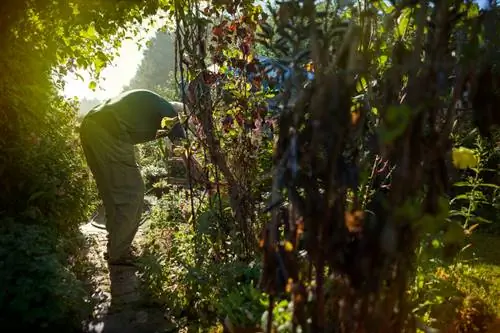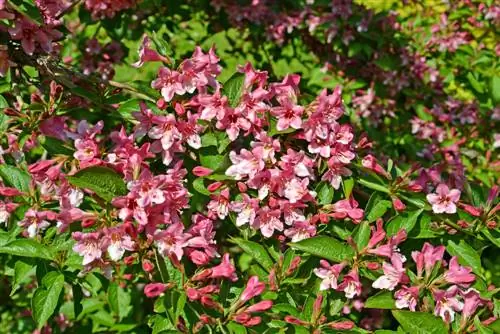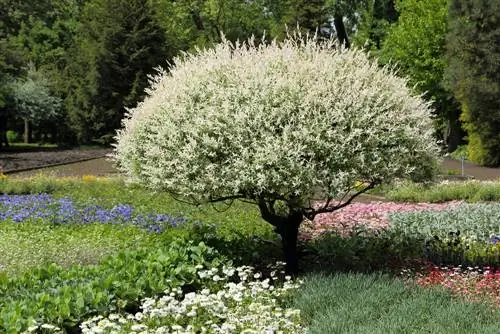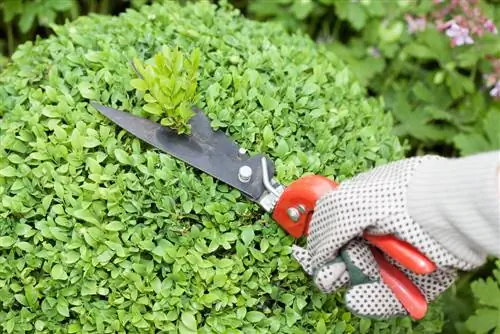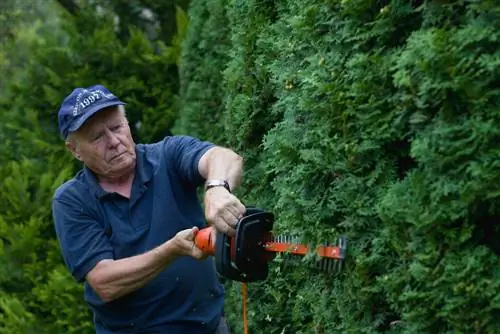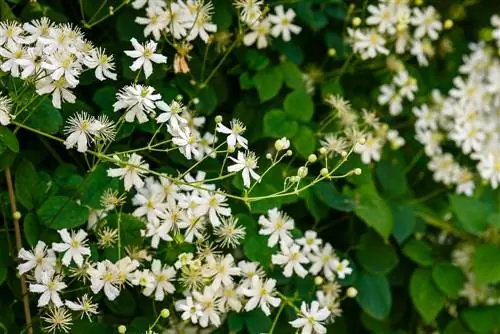- Author admin [email protected].
- Public 2023-12-24 06:09.
- Last modified 2025-06-01 06:02.
Clematis delight with their exuberant biodiversity. The furious selection ranges from early-blooming to summer-blooming to twice-blooming clematis. Care could be so easy if it weren't for the fact that different dates and cutting procedures had to be observed for pruning. Don't let yourself be unsettled any longer. This tutorial will familiarize you with all types of cuts at the right time.
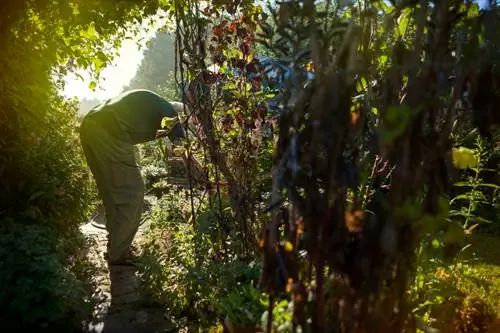
Cutting types and dates at a glance
An exuberant variety of magnificent clematis species and varieties makes pruning care seem like a complicated undertaking. In fact, some clematis are rarely or little pruned, while others require radical pruning. An important guideline for cutting time and procedure is the flowering time. The following table includes all important cutting types with recommended dates for the most popular clematis.
| Clematis flowering time | Cut style | best date | Cut style | best date | Cut style | best date |
|---|---|---|---|---|---|---|
| Early flowering species | Plant cutting | after planting | Thinning and preservation cut | after the flowering period in May/June | Rejuvenation cut | beginning of November to the end of February |
| Summer flowering species | Plant cutting | after planting/the following spring | Conservation cut | November to January | Rejuvenation cut | November to January |
| Twice flowering species | Plant cutting | after planting/the following spring | Conservation cut | November to January and June | Rejuvenation cut | in 5-year intervals in November/December |
Experienced clematis gardeners will notice the change in dates for summer and twice-blooming species. Until a few years ago, February was considered the ideal time for maintenance pruning. In the wake of global warming, experienced experts advocate cutting the clematis species mentioned between November and January. Mild winter climate leads to early budding, which falls victim to the scissors in February.
Background
Lawmakers have the final say in choosing a date
The scheduling of strong cuts in winter is not solely based on progressive global warming. Since the amendment to the Federal Nature Conservation Act in 2010, it is forbidden to radically cut any kind of tree between March 1st and September 30th. The reason for the provision is to protect wild animals such as breeding birds. During the summer grace period, light maintenance cuts may be carried out provided the measure does not disturb or drive away any animals. In order to emphasize the provision, violators face severe fines of up to 50,000 euros.
Planting pruning - pruning applies to all types of clematis
Regardless of the time of planting or subsequent flowering times, you should overcome all scruples and give your clematis a vigorous pruning. The purpose of the pruning measure is to create dense branching at the base of the young plant, which can only be made up for by later pruning as part of a radical rejuvenation. This is how expert plant pruning works on all types of clematis:
- The best time is immediately after planting
- Cut back all shoots to 20 or 30 centimeters above the ground
- Determine the cutting height so that one pair of buds remains standing
If you plant a flowering clematis in the ground as a container plant in summer, please do the planting pruning in November or December. The last date to benefit from the benefits of pruning is in February/March after the year of planting. In the case of spring-flowering clematis, pruning is at the expense of the next flowering period. We still recommend that you forego the few flowers in favor of a long-term, richly branched clematis in premium quality.
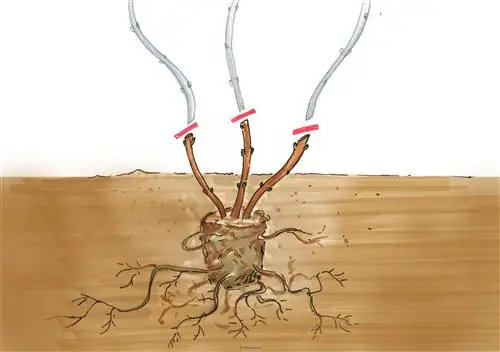
The plant pruning procedure applies to all types of clematis. Plant a young plant so deep that a pair of buds are in the soil. Then cut back all shoots except for a pair of buds above the ground.
Background
Pruning is based on the botanical law of growth
Are you wondering why the reaction of a clematis to the plant cut is predictable? The reason is the growth law of peak funding, which enables a reliable forecast. The central message is the realization that a top bud sprouts disproportionately more strongly than deeper buds. The cause is the intensive flow of sap towards the top of the plant in order to force growth towards the light. If the tip bud falls away, the excess sap flow is distributed to the remaining buds. The highest eyes are given priority. Since the planting cut on clematis leaves a single pair of buds, the sap pressure is concentrated at this point and causes sustained budding at the base of the bush.
Prune early bloomers a little - instructions for maintenance cutting
Popular species such as alpine clematis (Clematis alpina) or mountain clematis (Clematis montana) and their varieties as well as most wild species put on their flower dress in spring. The plants created the buds for the floral festival the previous year, often immediately after the flowering period. Pruning early-blooming clematis is tricky because it could destroy the flowering plants. Since clematis in this category naturally remain vital for many years, pruning is not part of the regular care program anyway. If the magnificent specimens grow over your head, bloom sparsely or are bare, a maintenance pruning will awaken your floral spirit. How to do it right:
- The best time is during flowering, at the latest by June
- Cut back shoots that are too long, bald or damaged by a third or half
- Cut above an outward-facing pair of eyes
- Cut off dead branches at the base
The subsequent time window is sufficient for strong growth and bud formation for the next year. As the illustration below demonstrates, ideally you do not cut back all shoots equally, but rather limit the extent to what is absolutely necessary.
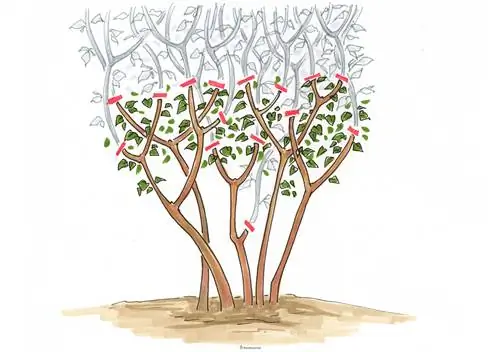
With a framework of 5 to 7 ground shoots, your garden marshmallow is well positioned for a blooming future. Ideally, 4 to 6 scaffold shoots are distributed around a higher central shoot. Valuable flowering wood emerges from the ground shoots every year.
Rejuvenate early bloomers - when and how to do it right
Its natural vitality does not protect an early-blooming clematis from floral signs of aging. When the branches age, become bare from below and every single flower is a sensation, you can no longer avoid a rejuvenation cut. This is how revitalization works with scissors and saws:
- Best time is between November and January
- Alternative date in February to March 1st
- First thin out the dead wood
- Cut back remaining shoots to a length of 30 to 60 centimeters
- Place scissors or saw above buds or sleeping eyes
Complete the rejuvenation cut with a generous portion of compost and horn shavings. Add 3 liters of mature leaf compost with 100 grams of horn shavings per square meter of root disk and water generously. Alternatively, stimulate growth with a clematis special fertilizer, such as Kölle’s Beste or Cuxin DCM.
Excursus
Decorative underplanting belies the bare shrub base
Clematis species that are rarely cut, such as Clematis montana and other early bloomers, tend to have a bare bush base. By planting the root disc with low-competitive perennials, you take the gap out of sight. Blue cushions, marigolds, fairy flowers and purple bells are suitable as underplanting. Because all clematis want a shady base and a sunny crown, species and varieties that are cut every year also benefit from the floral, shady foothold.
Cut summer bloomers vigorously - instructions for maintenance cutting
In the partially shaded location, the Italian clematis (Clematis viticella), the golden clematis (Clematis tangutica), the common clematis (Clematis vitalba) and their breathtaking hybrids, such as 'Jackmanii', bloom tirelessly from June to October. As is characteristic of summer-flowering shrubs, buds and flowers appear on this year's wood. After planting, pruning care follows special rules that take this growth into account. How to do it right:
- Best time is between November and January
- Prune all shoots rigorously back to 10 to 30 centimeters
- Carefully pull cut branches out of the climbing aid
The image below illustrates the vigorous pruning of summer-flowering clematis. The aim of the cut is the growth of this year's long shoots. The longer a new shoot grows in the summer, the more flowers it will produce. Combine maintenance pruning with nutrient supply in February/March to optimize the result.

Summer flowering clematis bloom on this year's shoots. A strong pruning before budding promotes growth and abundance of flowers.
Excursus
Cut perennial clematis like summer bloomers
Some of the most magnificent clematis species do not climb or become woody. Clematis integrifolia and varieties resulting from it bloom between June and September on this year's tightly upright, unwoody shoots. In winter the plants freeze back, as gardeners know from herbaceous perennials. Pruning to 20 centimeters between November and January creates space for fresh shoots in early spring. As a result, perennial clematis should be treated in terms of pruning care like their climbing, woody counterparts with summer flowering.
Rejuvenate old summer-flowering clematis - this is how it works
Gardeners rarely have to complain about senescence and baldness on summer-flowering clematis. The strong maintenance cut has a similar effect to continuous rejuvenation. If you have neglected pruning care for a few years or have inherited an uncut clematis, you can turn back time with this pruning guide:
- In November/December, shorten the entire climbing bush to 20 centimeters
- Consequence: the shoot pieces gradually dry back
- Result: fresh shoots from the rootstock
Do not cut off the over-aged branches at ground level, otherwise they will dry up to the roots and no longer sprout.
Tip
If a summer-flowering clematis ends its flowering period in July, this is not an indication of senescence. Under the influence of many hours of sunshine and high temperatures, the clematis simply exhausted itself. If you cut the climbing artist back again at the beginning of August, it will sprout again immediately and shine with new flowers in mid-September.
Clematis that bloom twice are best cut twice
Clematis, which bloom twice a year, present a challenge when it comes to pruning. The opulent hybrids with double flowers are a prime example of this floral masterpiece. The climbing bushes have their first flowering period from May to June with short shoots that sprout from last year's wood. The second flower floret from August to September unfolds on this year's long shoots and appears as unfilled flowers. How to master the maintenance cut with flying colors:
- The best time for the first cut is between November and January
- Short climbing vines by a third or a quarter
- Cut back slow-growing clematis by half
- The best time for the second cut is in June
- Cut off the wilted flowers until the next pair of leaves
The focus of pruning care is on the annual shoots with their short, lateral branches. This is where the lushly filled clematis flowers appear in early summer. The less of the valuable flower wood is preserved, the more magnificent the appearance. The late summer blooms benefit from cleaning out the withered flowers. The clematis does not invest energy in the growth of seeds but instead directs its energy into new flowers.
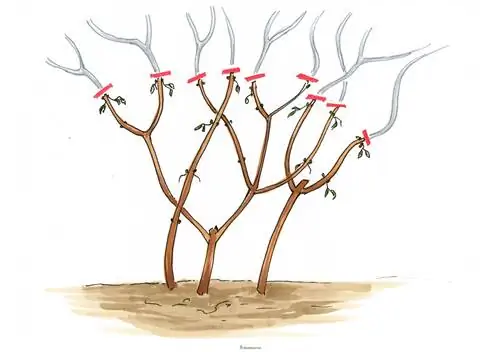
Clematis that bloom twice should be cut back by between a quarter and half in late winter and thinned out thoroughly. Variable cutting heights promote better distribution of flowers. After the first bloom, it is beneficial to clean out withered flowers.
Background
Distinguishing between shoot types means optimizing the cutting result
If you shorten all shoots by half during winter pruning according to the instructions above, you haven't done anything wrong. An acceptable number of the flower buds that have already been created remain for the first flower bloom. You can significantly increase the abundance of flowers if you are selective when cutting. Spare annual, bud-bearing branches from pruning completely. You can identify the valuable flower wood with lush, double flowers by its almost unbranched growth. At the time of maintenance pruning, the dead branches from the previous year are perennial and noticeably branched, so they are cut back by half. The second flower floret with simple flowers appears on the resulting shoots in summer.
Rejuvenate twice-flowering clematis regularly - step-by-step instructions
Moderate cutting on twice-flowering clematis inevitably results in premature senescence. An impenetrable tangle of old, young and dead shoots forms, calling for the gardener's organizing hand. Use scissors and a saw to stop the aging process by making rejuvenation cuts at 5-year intervals. Here's how to proceed expertly step by step:
- Cut all shoots back to a height of 30 to 50 centimeters
- Ideally choose a pair of sleeping eyes as a starting point for scissors or saw
- Do not cut dead wood level with the ground, but shorten it to 20 centimeters
There is no reason to worry if all the shoots dry back immediately. Continue to supply nutrients and water unwaveringly, even if there are no longer any soil shoots to be seen. Under normal conditions, you can look forward to vigorous shoots and a rejuvenated clematis next spring, or the spring after next at the latest.
Excursus
Perfect cut starts near the bud
Clematis thrive with opposite buds. This requires special cutting technique as part of pruning care. A vital shoot depends on you cutting at a short distance from two eyes opposite each other. Ideally, place the scissors 3 to 5 millimeters above a pair of buds. If you cut too far away, the shoot stub will hinder sprouting. If you cut too close or into the buds, they will dry out and die. Hold the scissors at a slight angle away from the pair of buds so that rain and irrigation water drains away quickly.
Frequently asked questions
Are all clematis hardy?
With a few exceptions, Clematis species and varieties are well hardy. Light winter protection is recommended for Clematis florida, Clematis texensis and evergreen species such as Clematis armandii. Prolonged winter wetness in the bed is more problematic than severe frost. It is therefore advisable to cover the root disc with coniferous twigs to protect against hail, snow and constant rain. In the pot, the frost hardiness of clematis is limited due to the exposed position of their root balls. Before the onset of winter, cover the containers with fleece, jute or bubble wrap and push a block of wood under the bottom of the pot.
Are clematis poisonous?
Clematis hold a poisonous secret. Unfortunately, the magnificent flowering plants are filled with toxic protoanemonin and other toxins. A brief skin contact is enough to cause allergic reactions to the affected gardener. Eating flowers, fruits or leaves causes nausea and vomiting. Animals are also not immune to the toxins. Therefore, please choose the location for clematis out of the reach of children and animals. Wear protective clothing when caring for and cutting work. As a precaution, dispose of the clippings in the organic waste bin and not on the compost.
How can I tell if a leafless clematis shoot is still alive?
When clematis are dormant, they have no leaves and appear lifeless. To be able to distinguish live wood from dead wood, carry out the vitality test. To do this, cut off a piece of shoot and check the cross section to see whether the inside is still green and juicy. However, if brown, dry tissue appears, you can thin out the branch.
When is the best time to plant clematis?
Experienced clematis experts, such as Germany's leading clematis breeder, Friedrich Manfred Westphal, advocate late summer and early autumn as the best planting time. During the months of August, September and October, young clematis find the ideal conditions. At a soil temperature of 14 to 20 degrees Celsius, the plants root quickly and start their first gardening season in spring with a vital growth lead.
The leaves of my evergreen clematis turned brown in winter. Should I remove the foliage or cut back the entire plant?
Evergreen clematis react to bright winter sun and severe frost with brown, wilted leaves. Remove the frozen leaves and strengthen the clematis with fertilizer so that it sprouts fresh leaves. If you cut the plant back now, this year's flowers will fail. Evergreen species do it, such as Clematis montana, Clematis alpina or rhododendrons and forsythia; They lay the buds for the next flowering period in the summer of the previous year.
Clematis with clematis wilt - what can I do?
Gardeners have so far been fighting a losing battle against clematis wilt. The fatal disease is caused by a fungal pathogen that has so far proven to be resistant to pesticides. For this emergency situation, the pair of buds that you put in the ground when planting is intended as an iron reserve. Cut the affected clematis back to just above the ground and apply a good fertilizer. The plant's defenses decide whether new shoots will begin. While you wait, make sure you have a balanced supply of water and nutrients. If you don't want to have to deal with clematis wilt in the future, plant the Italian clematis (Clematis viticella) and its resulting varieties, which are largely spared from the disease.
My clematis comes from the new Envipo breeding line. What should you pay attention to when pruning?
The magical novelties in the realm of clematis delight with huge, lush, double flowers. The flowering period extends from June to October. This results in the rules for summer-flowering species and varieties when it comes to pruning care. Between November and December, cut all shoots back to 30 centimeters. Buds for next year's flower show only appear on fresh shoots, so you can't go wrong with a winter date.
The 3 most common cutting mistakes
Clematis pruning seems complicated at first glance. Don't let different pruning methods and timing prevent you from integrating the high-quality flower beauty into your garden design. Act according to the motto “Practice makes perfect”. Thanks to a good-natured cutting tolerance, most cutting errors can be eliminated within a short time. The following table would like to protect you from the three most common mistakes:
| Cut style | malicious image | Prevention/Correction |
|---|---|---|
| Early flowering species cut in late winter | Total failure of this year's flowering period | Cut spring bloomers in May/June |
| Summer flowering species never cut | few flowers, premature aging | Cut back summer bloomers heavily every year |
| no plant cutting | sparse branching at the base of the bush | After planting, shorten all shoots to 20-30 cm |

Tip
In refined clematis varieties, the wild rootstock can sometimes come through. Tightly upright wild shoots sprout from the root disk, which compete with the noble part for its water and nutrient supply. You can identify the strong-growing water shooters by their different foliage shape and by their large, noticeably larger leaf spacing, called internodes. Remove wild shoots as quickly as possible so that they do not overgrow the noble clematis.

